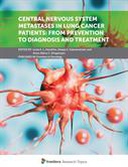Explore

Central Nervous System Metastases in Lung Cancer Patients: From Prevention to Diagnosis and Treatment
0 Ungluers have
Faved this Work
Login to Fave
Approximately 40% of lung cancer patients will develop central nervous system (CNS) metastases during the course of their disease. Most of these are brain metastases, but up to 10% will develop leptomeningeal metastases. Known risk factors for CNS metastases development are small cell lung cancer (SCLC), adenocarcinoma histology, epidermal growth factor receptor (EGFR) mutant or anaplastic lymphoma kinase (ALK) rearranged lung cancer, advanced nodal status, tumor stage and younger age. CNS metastases can have a negative impact on quality of life (QoL) and overall survival (OS). The proportion of lung cancer patients diagnosed with CNS metastases has increased over the years due to increased use of brain imaging as part of initial cancer staging, advances in imaging techniques and better systemic disease control. Post contrast gadolinium enhanced magnetic resonance imaging (gd-MRI) is preferred, however when this is contra-indicated a contrast enhanced computed tomography (CE-CT) is mentioned as an alternative option. When CNS metastases are diagnosed, local treatment options consist of radiotherapy (stereotactic or whole brain) and surgery. Local treatment can be complicated by symptomatic radiation necrosis for which no high level evidence based treatment exists. Moreover, differential diagnosis with metastasis progression is difficult. Systemic treatment options have expanded over the last years. Until recently, chemotherapy was the only treatment option with a poor penetration in the CNS. Angiogenesis inhibitors are promising in the treatment of primary CNS tumors as well as radiation necrosis but clinical trials of anti-angiogenic agents in NSCLC have largely excluded patients with CNS metastases. Furthermore, research has also focused on methods to prevent development of CNS disease, for example with prophylactic cranial irradiation. Recently, checkpoint inhibitors have become available for NSCLC patients, and tyrosine kinase inhibitors (TKIs) have improved prognosis significantly in those with a druggable driver mutation. Newer TKIs are often designed to have better CNS penetration compared to first-generation TKIs. Despite advances in treatment options CNS metastases remain a problem in lung cancer and cause morbidity and mortality.This Research Topic provides an extensive resource of articles describing advances in CNS metastases management in lung cancer patients, from prevention to diagnosis and treatment.
This book is included in DOAB.
Why read this book? Have your say.
You must be logged in to comment.
Rights Information
Are you the author or publisher of this work? If so, you can claim it as yours by registering as an Unglue.it rights holder.Downloads
This work has been downloaded 424 times via unglue.it ebook links.
- 195 - mobi (CC BY) at Unglue.it.
- 123 - epub (CC BY) at Unglue.it.
- 106 - pdf (CC BY) at Unglue.it.
Keywords
- brain metastases
- cranial radiation
- Diagnosis
- driver mutations
- leptomeningeal metastases
- lung cancer
- prediction
- Treatment
Links
DOI: 10.3389/978-2-88945-707-6Editions

